By Christine Woodside
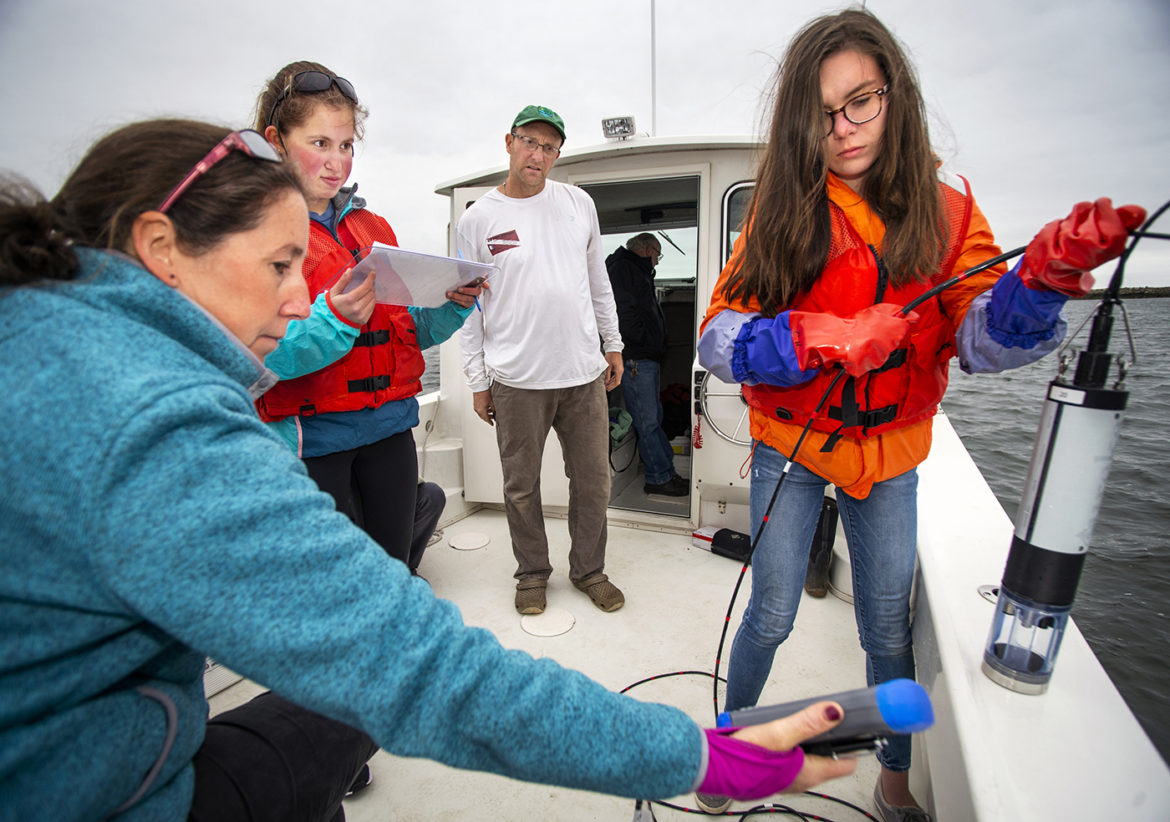
Melanie Stengel Photo.
This group devoted many early
mornings in spring and summer as citizen scientists taking water samples
to test the quality. Pictured are: Holly Turner, a teacher at the
Bridgeport Regional Vocational Aquaculture School; Lyle Given, and
Charlotte Hickey, both students. Kevin Blagys, a volunteer, observes
their work.
At 6:25 a.m. on the cloudy, humid first day of summer, two teenage aquaculture students huddle at the back of their school boat as it backs away from a dock in Black Rock Harbor in western Bridgeport.
Charlotte Hickey grips a heavy cylindrical metal probe that is about a foot and a half long. The students call this “the beast.” It contains electronics that precisely measure water conditions. Sienna Matregrano holds a clipboard and pen, ready to record depth, temperature, salinity, dissolved oxygen, fluorescence and turbidity. Both girls are seniors at Bridgeport Regional Vocational Aquaculture School.
They’re up early because they must take water quality readings in Black Rock Harbor when it lies still. Like most residents of the Black Rock area, they’re tired of sewage overflows, smelly water and beaches closed to swimming—mostly caused by overflows at the Bridgeport West Side Water Pollution Control Facility sewer plant.
The students have devoted many early mornings of the spring and summer of 2019 volunteering as citizen scientists in a Long Island Sound-wide study of water quality. Called the Unified Water Study, the initiative is administered by Connecticut Fund for the Environment and its program Save the Sound. The Bridgeport group is one of 22 taking water samples at 36 embayments of Long Island Sound in Connecticut and New York.
The study’s goal is to understand the whole Sound’s water quality, and so the Black Rock citizen scientists follow strict guidelines. They take readings every two weeks in the same six locations from the mouth to the furthest inland stretch of Black Rock Harbor in the same way at the same time of day.
Under the director of teacher Holly Turner, Hickey has worked all of the collections. Matregrano rotates as data recorder with Lyle Given, a senior at the aquaculture high school.
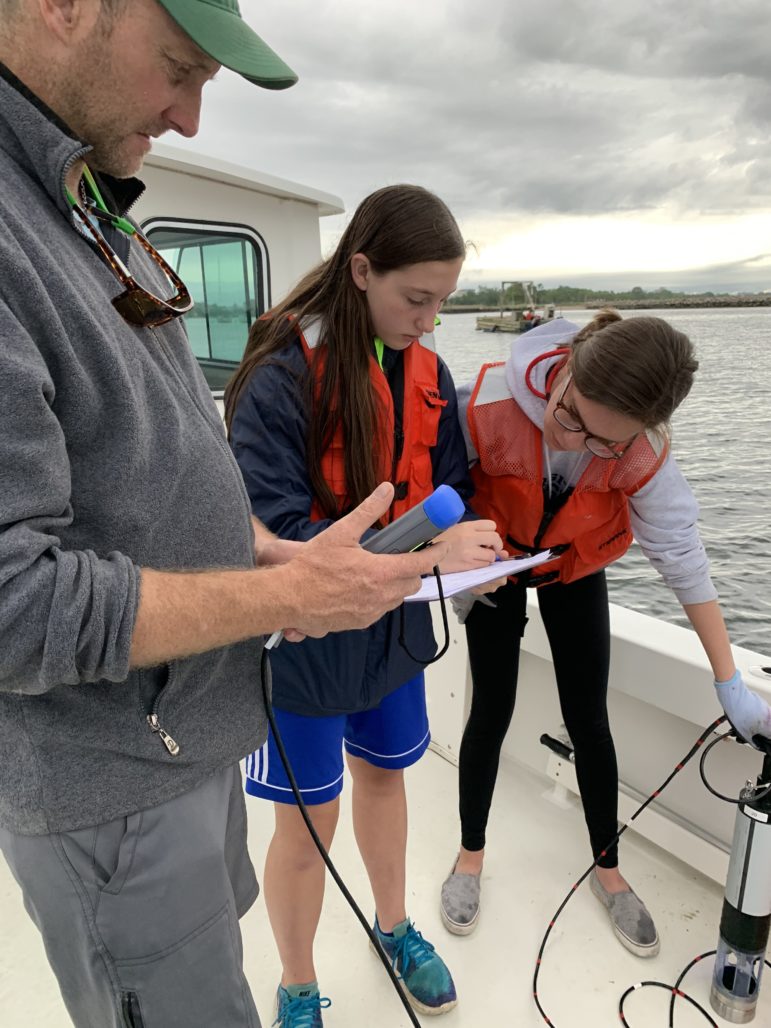
Christine Woodside Photo.
Kevin Blagys, a study volunteer, and students Sienna Matregrano and Charlotte Hickey, both from Fairfield, check their equipment for testing.
Working with them is Kevin Blagys, who operates a one-man diving and salvage service in these waters. Blagys offered his boat, although often they use the school’s, and he helps check the figures. Blagys also has devoted hours to helping with the logistics of the study, and, using his own boat, collects seaweed and chlorophyll samples.
The last data collection is Oct. 18, so any results now are localized and don’t take into account the context of the greater Long Island Sound, which is how the unified study is designed. But the readings here in Black Rock indicate water with high nitrogen levels (because of the sewage effluent) and diminishing health as the warm season progresses.

Indeed, in their preliminary results the students are finding alarming proof of the poor health of the water. For a snapshot of declining health, one only has to compare readings from the first day the citizen scientists recorded conditions, May 10, with the readings three months later. Hypoxia, or too little oxygen to support most marine life, occurs when oxygen measures below 5 milligrams per liter. In Long Island Sound, high nitrogen levels from sewage treatment—even when plants are operating perfectly—is the cause of hypoxia.
At testing station 3, near Captain’s Cove Seaport, oxygen on the bottom declined from 100% on May 10 to 38% on Aug. 9. At the surface it went from 100% in May to 55% in August.
Farther inland, near Santa Energy and I-95, dissolved oxygen at the bottom went from 67% in May to 25% in August. At the surface it dropped from 99% in May to 30% in August.
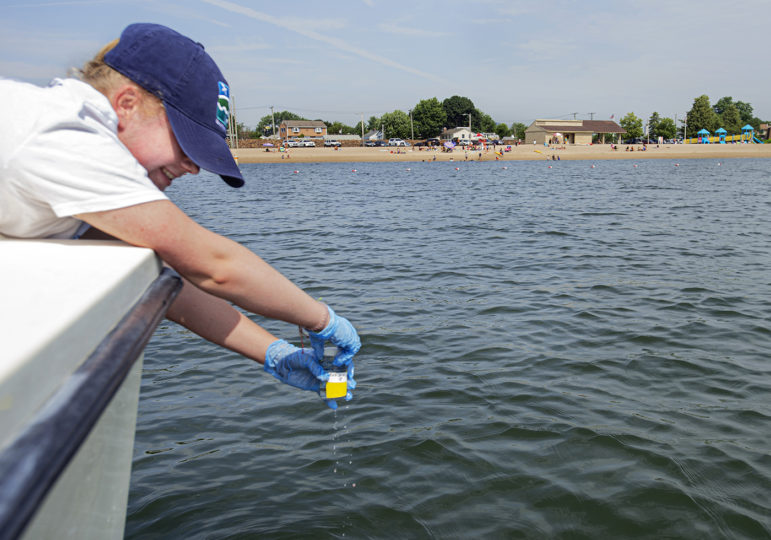
Melanie Stengel Photo.
Megan Dear, a volunteer working on the Soundkeeper’s boat, takes a sample at Jennings Beach, Fairfield.
At the harbor’s mouth, dissolved oxygen measured 100% on the bottom and at the surface in May. By August that went down to 45% on the bottom and 62% at the surface.
They test also for turbidity, or suspended particles in the water, which remains high.
And they test for chlorophyll, an indicator of plant life. As the season warms up, oxygen in the harbor is depleted, making it more difficult to sustain marine life. “The other staggering reading is the chlorophyll levels,” Blagys said in mid-August. “They greatly increase as we go up the harbor” inland.
Chlorophyll readings Blagys collected told a story too. “I was surprised at our first testing on the 10th
[of May]
. It was already very green,” Blagys said, although the water temperature was still in the 50s at that time. “The water’s alive.”
Meanwhile, Bill Lucey, the Long Island Soundkeeper for the Connecticut Fund for the Environment/Save the Sound, started testing Black Rock Harbor near the discharge pipe of the West Side facility in June.
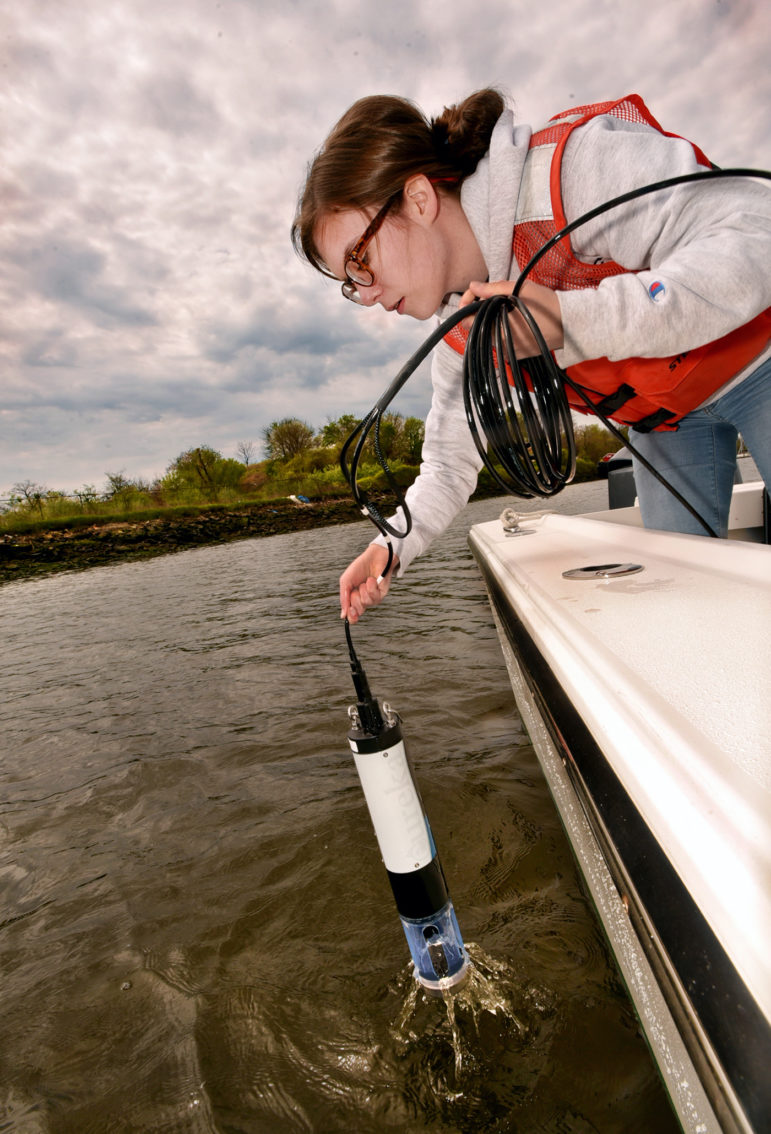
Melanie Stengel Photo.
Charlotte Hickey of Fairfield, a student at the Bridgeport Regional Vocational Aquaculture School, lowers “the beast” into the water.
His probe has measured dissolved oxygen at 0 from his first tests. Then sometime in July, what he calls “this big organic mat,” or blobs of black matter floating up from the bottom, began to clog his probe. “In a healthy embayment, the top few centimeters of the bottom sediment should have oxygen,” he said.
“There should be clams and worms making holes,” Lucey said. Deeper down you’d find anaerobic bacteria, which doesn’t need oxygen, he said.
Black Rock Harbor qualifies as an unhealthy embayment. The sediment near the top also lacks oxygen. The result is methane production on the bottom. The boaters docked near the discharge pipe see the bubbles bursting into patterns as they start their engines.
On the boat, the students, Turner and Blagys act as a well-oiled team. They’ve been doing this for months. The boat reaches the first test collection spot and hovers as Hickey lowers the beast into the water. Turner reads off the device that records the conditions, calling out figures to Matregrano, who writes them down on the study’s preprinted chart blanks.
As the boat moves to the next stop, Hickey and Turner pull the beast out of the water and go to the back of the boat to hose off blobs of thick, black mud.
Blagys said he “kind of literally jumped into this. After 13 years in business, diving in the harbor and seeing the state of it, and it really becomes in a crisis mode for two months for July and August with the hypoxia and the fish kills,” he said. He wanted to do something.
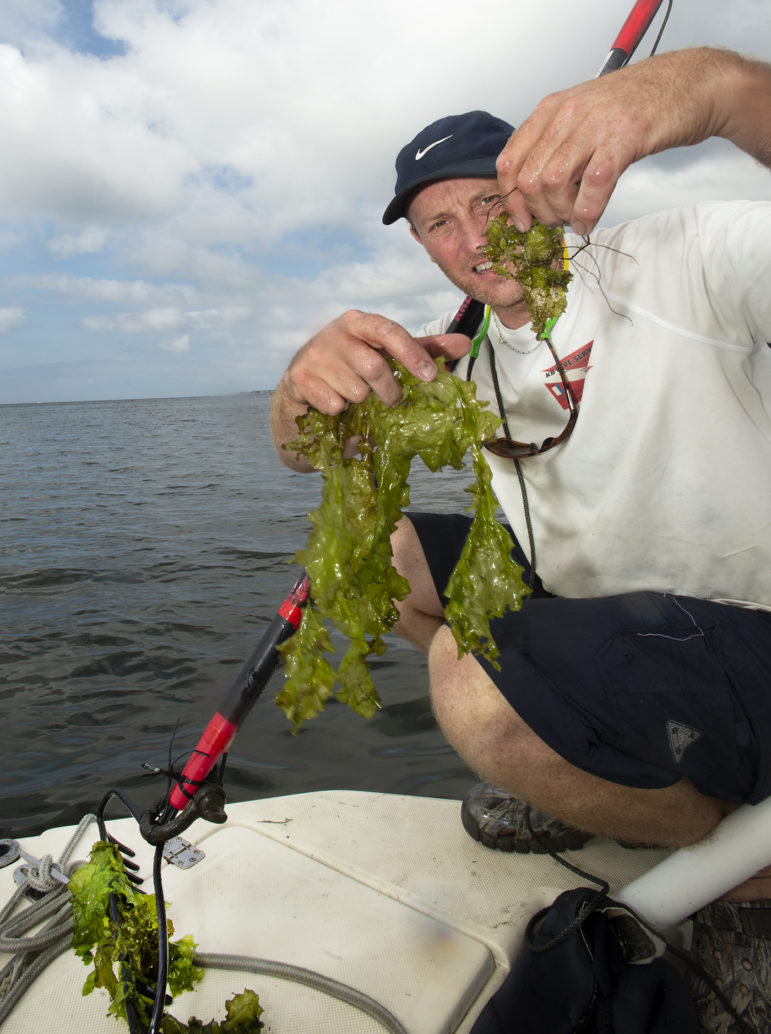
Melanie Stengel Photo.
Kevin Blagys, a nationally-ranked snowboader, volunteered his time and boat for the Unified Water Study of Long Island Sound. Here he shows seaweed that will be tested.
So did the other residents of Black Rock who attended a summer 2018 meeting organized by City Council member Peter Spain. “We found out about this study,” Blagys said. “It was pretty much Bill Lucey with Save the Sound and Holly Turner. They got together and said, ‘How can we run this thing?’ ”
“We’re sort of all citizen scientists,” Blagys said.
Blagys said he was eager to “give back” to the water where he makes his living, and is delighted that finally the water quality in the Black Rock area would get independent attention. “In the previous studies, the water hasn’t been monitored here in Bridgeport,” he said.
As soon as Turner told the students about the water study, Hickey signed up. She said that over the past three years the water in Black Rock Harbor looks more polluted than it ever has. She’s worked at Captain’s Cove with her family since she was in second grade. She sells her own cleverly painted shells—some look like Santa Claus—and she talks to a lot of tourists. Hickey’s family sells ice cream and runs a few other little stores on the boardwalk at Captains Cove Seaport. The brightly painted shops cluster over the well-kept boat docks. Music plays from the restaurant deck speakers at the northern end. You can smell fried seafood, french fries—and the sewage plant.
Since the West Side facility began operating in the late 1940s, residents have lived with regular flows of effluent (treated sewage).
Since the West Side facility began operating in the late 1940s, residents have lived with regular flows of effluent (treated sewage). The discharge pipe is designed to emit up to 30 million gallons a day, but it regularly sends out more out of its 72-inch mouth directly below Captain Cove’s restaurant deck.
When the study ends in October, residents may understand better the problems in this water. For now, they are noticing that the dissolved oxygen went way down as the summer went on and the water heated up. They see high nitrogen levels and high turbidity (cloudiness) in areas.
The Future
Bridgeport is under orders from the state to correct its sewage overflow problem by 2039. Once all the work is done, Lucey said, the harbor would need about 20 more years to recover. So if the city stops overflows by 2039, the harbor will be clean by 2059.
Waterways do recover when sewage outflows are moved. A case in point is Mumford Cove in Groton. The sewage outflow was moved to the Thames River in 1987. Fifteen years later, the cove’s natural eelgrass ecosystem had recovered.
Lucey said that Black Rock Harbor should be dredged so that it has a chance to recover, once the sewage overflows are halted.
The recovery in Black Rock rides, too, on other industry being careful. Over the summer, some spilled gravel caused the water to look as blue as a glacial lake for a day.
Climate change will also affect how the harbor recovers.
Connecticut is getting wetter and warmer, which means more rain will infiltrate sewage and stormwater pipes. Warmer summers increase the interactions of heat, sun and nitrogen that lower water oxygen levels.
The people in Black Rock have decided that whatever the odds against the harbor might seem to be, they want to do something. “We basically got the Unified Water Study started in Black Rock with no federal funding,” Lucey said. “They self-funded.”
Spain, Santa Energy, and Blagys donated time and boat time. The aquaculture high school donated its boat and captains. Ash Creek Conservation Association donated money and acted as the fiscal agent for buying equipment. Captain’s Cove provided free boat slips.
“A half dozen entities donated resources to make that happen,” Lucey said. “People put their money where their mouth is.”
Read the 3-part series on C-HIT.org.
Part 1: A typical rainstorm in Bridgeport overwhelms the West Side sewage treatment plant. Over the past five years, hundreds of millions of gallons of bypassed waste have poured into Black Rock Harbor. Combined sewage overflow pipes have diverted hundreds of thousands of gallons of untreated waste. A murky thick foam filled with objects people flushed down the toilet lingers for days. Residents say that they should not have to live with this.
Part 2: A catalog of West Side plant malfunctions and discharges into Black Rock Harbor; how sewage problems persist in other cities.
Part 3: Black Rock area residents, including high school students, spent the spring and summer cruising the harbor and Long Island Sound gathering water samples for testing. They’re part of the Long Island Sound Unified Water Study, and like many living and working in the area they’re tired of the smelly, brown-slick water and beaches closed to swimming.
This project was supported by a grant from the Society of Environmental Journalists – Fund for Environmental Journalism.

How C-HIT’s Christine Woodside reported this project: Christine Woodside had long wanted to understand why sewage overflows regularly in some of Connecticut’s cities. She settled on the Bridgeport neighborhood of Black Rock, on Black Rock Harbor and near the promenades of Seaside Park. There she found recreation, industry, and local people who were getting tired of pollution. She went to Black Rock at least a dozen times between late March and late July. She read sewage plan documents. She scouted. She tagged along with citizen scientists collecting water. She sought out the overflow pipes with diver/boat cleaner Kevin Blagys. She wandered around the docks, streets, beaches, and markets. This gave her a sense of the residents’ anxieties and the enormity of the project to stop overflows.
Support Our Work
The Conn. Health I-Team is dedicated to producing original, responsible, in-depth journalism on key issues of health and safety that affect our readers, and helping them make informed health care choices. As a nonprofit, we rely on donations to help fund our work.Donate Now
Related Stories
- Dead Fish, Condoms, Brown Foam: Sewage Has Chokehold On Black Rock Harbor On April 25, 2018, Patrick Clough walked onto a dock at Fayerweather Yacht Club on Black Rock Harbor in western Bridgeport. He looked down.
More From C-HIT
- Disparities Coordinated Care Practices Help Keep HUSKY Members Out Of ERs
- Environmental Health Citizen Scientists Steer Efforts To Jumpstart Black Rock Harbor’s Recovery
- Fines & Sanctions 26 Hospitals Penalized By Medicare For High Readmission Rates
- Health Care Health Bills’ Failure A Bitter Pill For Health Care Proponents
- I-Team In-Depth Citizen Scientists Steer Efforts To Jumpstart Black Rock Harbor’s Recovery

